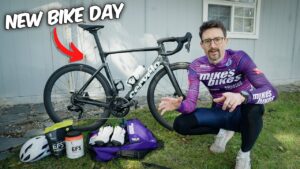THIS is why you should run lower tire pressure | NorCal Cycling
Source: NorCal Cycling Youtube Channel: THIS is why you should run lower tire pressure
Video THIS is why you should run lower tire pressure with NorCal Cycling
Video THIS is why you should run lower tire pressure with NorCal Cycling YouTube Channel.
THIS is why you should run lower tire pressure
NorCal Cycling: The Sweet Spot for Tire Pressure
When it comes to cycling, one of the most debated topics among riders is tire pressure. The recent trend has seen a shift towards lower tire pressure for better performance, but is this really the case? In a recent YouTube video, two cyclists set out to put this trend to the test. Jeff and Blaine, from Thirsty Bear, received a care package from Performance Bike and decided to conduct their own real-world experiment to determine which tire pressure is the fastest.
The Experiment: Testing Tire Pressure on a Challenging Course
The experiment entailed fitting their bikes with new tires from Performance Bike, entering the base season. They aimed to test tire pressures of 100 PSI, 75 PSI, and 50 PSI on the same course to determine the impact on speed, performance, and comfort. They emphasized the importance of considering factors not accounted for in online tire pressure calculators, such as cornering, road conditions, and the overall “feel” of the bike.
The setup was simple – the two riders used the same tires on their respective bikes, ensuring all other variables remained constant. The goal was to find the sweet spot for tire pressure – the pressure that would offer the best performance, comfort, and speed, especially on challenging terrain with corners and pavement variations.
Initial Impressions: A Shift in Perspective on Tire Pressure
Jeff and Blaine shared their initial thoughts on tire pressure, highlighting the evolution of their own preferences over the years. Jeff noted that, just six years ago, he would have opted for 23mm tires at 120 PSI, a choice that now seems antiquated. He mentioned that the trend among elite cyclists and criterium racers was shifting towards higher-volume tires at lower pressures. This transition mirrored the industry’s evolving approach to tire pressure, with a clear shift towards lower pressures for enhanced stability and comfort.
Preliminary Results: The Impact of Varying Tire Pressure on Performance
As the two riders completed their runs at 100 PSI, 75 PSI, and 50 PSI, they noticed significant differences in how their bikes handled the challenging course. At 100 PSI, Jeff remarked that everything on his bike was “chattering,” and the ride felt considerably harsher than expected. This contradicted the conventional belief that higher pressures equated to improved performance on smoother surfaces. Blaine also noted that the ride at 100 PSI felt uncomfortable and resonated with Jeff’s sentiments.
As they progressed to the 75 PSI run, both riders expressed a sense of familiarity, with this pressure aligning more closely with their usual preferences. The run at 75 PSI felt comfortable, and the ride quality was notably smoother than at 100 PSI. However, the real revelation came during the final run at 50 PSI. Jeff was surprised by the performance, noting that the ride felt excellent, despite initial concerns about excessive squishiness. Blaine echoed these sentiments, highlighting the comfort and stability of the bike at the lower pressure.
Unanticipated Results: The Equalization of Performance Across Tire Pressures
The most unexpected revelation emerged when they analyzed the data from their runs. Despite their initial assumptions, the performance across 100 PSI, 75 PSI, and 50 PSI was virtually equal. The consistency in their speed and power output at varying pressures challenged their preconceived notions, leaving them both surprised by the results. Blaine’s faster time at 75 PSI compared to 100 PSI further reinforced the notion that lower pressures might offer a performance advantage without sacrificing comfort.
Insights and Considerations: The Case for a Personalized Approach to Tire Pressure
The experiment sought to provide clarity on the optimal tire pressure, especially given the shifting industry trends and evolving preferences among cyclists. While the data indicated that there was no significant performance penalty associated with lower tire pressures, both cyclists emphasized the need for a personalized approach. Jeff cautioned against a rapid shift to substantially lower pressures, highlighting the potential safety risks and the importance of gradually adjusting tire pressure to find a suitable balance.
Finding the Sweet Spot: Implementing a Gradual Adjustment Process
Jeff and Blaine advocated for a systematic approach to discovering the ideal tire pressure, emphasizing the need for riders to start with their current pressure and progressively lower it in small increments. This methodical process would allow cyclists to assess the impact of lower pressures on familiar routes and cornering, ensuring that they strike the perfect balance between comfort and performance.
Key Takeaways: Rethinking Traditional Assumptions about Tire Pressure
The experiment’s findings challenged conventional assumptions about tire pressure, shedding light on the viability of lower pressures for enhanced comfort and comparable performance. While the individual thresholds may vary, the consensus revolved around the need for a gradual and mindful adjustment process to identify the ideal tire pressure for individual riders.
The Road Ahead: Embracing Versatility and Personalization in Cycling
The insightful experiment conducted by Jeff and Blaine underscored the dynamic nature of cycling preferences and the importance of adapting to evolving industry trends. The embrace of higher-volume tires and lower pressures heralded a new era in tire pressure considerations, emphasizing the value of individualized approaches to optimization. As cyclists continue to pursue innovative strategies for performance enhancement, the shift towards personalized tire pressure settings is set to redefine the cycling landscape.
The opinions expressed in this space are the sole responsibility of the YouTube Channel NorCal Cycling and do not necessarily represent the views of CicloNews.










